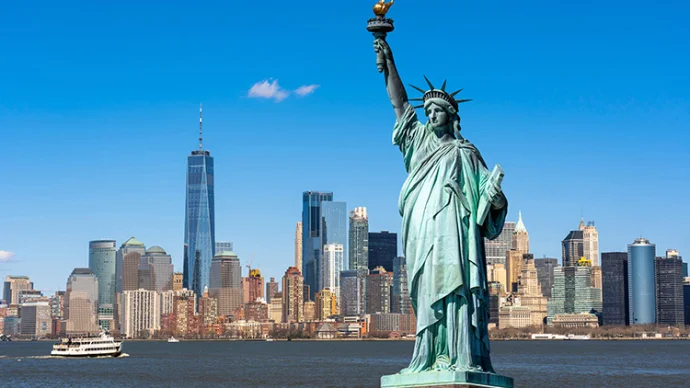
About Ellis Island
Ellis Island in New York Harbour was the entry point into the United States of America for over 12 million immigrants between 1892 and 1954. In the 19th century however, the island was the site of Fort Gibson and later, a naval magazine.
Today, Ellis Island is part of the Statue of Liberty National Monument accessed by a ferry, also home to the Ellis Island Immigration Museum and Wall of Honor.
Ellie Island history
Prior to its better-known function as an immigration control point, Ellis Island had been owned by the state of New York. The island was purchased by the federal government in 1808, first for use as a fortification as military tensions continued with Britain after the American War of Independence. Fort Gibson operated on Ellis Island as a barracks and jail for British prisoner during the war of 1812. The magazine was expanded during the Civil War but afterwards fell into decline.
Following the shift of immigration powers from individual states to the federal government in 1890, as the port for immigration into New York. Nearby Castle Garden had originally served this purpose, but more space was needed due to the influx of mostly European migrants in the 19th century.
The Ellis Island Immigration Station (which today operates as a museum) was the second such building on the Island, completed in 1900 after the original burnt down. Ellis Island served as a checking point for disease and legal issues of those incoming “steerage” passengers who could not afford a first or second ticket on the boats, as those with such tickets were assumed unlikely to have any such issues.
Ellis Island was known as the “Island of Tears” for the 2 percent of migrants refused entry to the US, usually due to being diagnosed with a contagious disease or considered likely to commit crime. However, Ellis Island was generally regarded as a symbol of hope, particularly with its location in the shadow of the Statue of Liberty, which had been dedicated in 1886.
The myth that newcomers were forced to change their names has so far been left unproven, although many recent immigrants Americanised their names within the first 5 years after arriving. After 1924, Ellis Island was mostly used as a detention centre, particularly during World War Two, by which time most immigration procedures were carried out in consulates.
Ellis Island today
Enjoy a ferry journey over to Ellis Island with fantastic views of the Big Apple, overlooked by the monumental Statue of Liberty. You can still see the elegant and impressive processing room which welcomed newcomers to America, contrasted with the sterile dorms used for quarantining migrants with suspected disease.
The Ellis Island Immigration Museum offers a detailed insight into the island’s history, its role in the country’s immigration procedures and the stories of the immigrants. Primarily, the museum is a celebration of immigration and includes the Wall of Honour, which since 1990 has marked 775,000 names including those of slaves, indigenous Americans and immigrants who were not processed on the island.
Getting to Ellis Island
Visitors arrive and depart Ellis and Liberty Islands, located in New York Harbour, via ferries operated by Statue Cruises. These ferries leave from two locations: Battery Park, at the southern tip of Manhattan in New York City, and Liberty State Park in Jersey City.
Featured In

US Historic Sites
Discover some of the best historic sites in the United States, from iconic sites like the White House, Statue of Liberty, and Mount Rushmore, to the more hidden historical gems like Historic Jamestowne, Taos Pueblo, and the Freedom Trail in Boston.




















